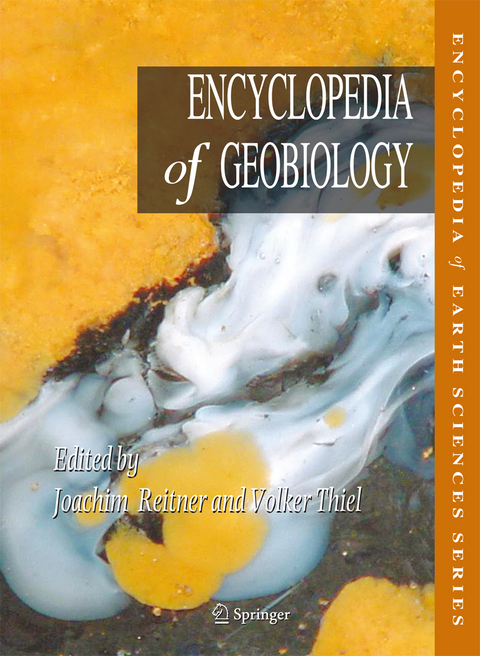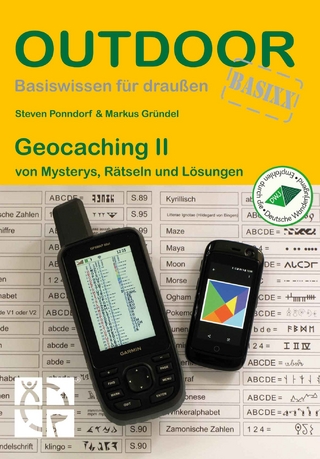
Encyclopedia of Geobiology
Springer-Verlag New York Inc.
978-1-4020-9211-4 (ISBN)
Dr. Joachim Reitner is Professor of Paleontology, Head of the Department of Geobiology, and Managing Director of the Museum, Collections and Geopark, at the University of Göttingen, Germany. He is also Editor-in-Chief of Lecture Notes in Earth Sciences (Springer), Co-Editor of Facies (Springer), and Associate Editor of the Geomicrobiology Journal (Taylor & Francis). Dr. Reitner’s research focuses on the interplay between organisms and their metabolic processes with various abiotic parameters. Many geological processes can be understood as geo-physiological processes, allowing chemical reactions that would never run under standard thermodynamic conditions. Therefore, a major thrust of Dr. Reitner’s research activities is the investigation of the evolution of these processes, visible in biosignatures and biomineralization patterns and their interaction with biogeochemical cycles. Among his many honors and accolades, Dr. Reitner is the recipient of the G. W. Leibniz Award from the Deutsche Forschungsgemeinschaft. Dr. Volker Thiel is Professor of Organic Geochemistry in the Geoscience Center at the University of Göttingen, Germany. Dr. Thiel has been involved in geobiological research for some 15 years, with a focus on the use of organic molecules as chemical tracers (biomarkers) for biogeochemical pathways. His research interests include lipid biomarkers as indicators for biogeochemical processes; molecular fossils, biological formation, and turnover of methane; and microbial control on mineral formation. The results of his studies have significantly contributed to identifying the microbial processes associated with methane turnover in modern and ancient environments. Much of Dr. Thiel’s current work is devoted to new approaches to enhance the spatial resolution of biomarker analysis in geobiological systems.
Acetogens.-Acid Rock Drainage.-Acidophiles.-Aerobic Metabolism.-Algae (Eukaryotic) .-Alkalinity.-Amber.-Anaerobic Oxidation of Methane with Sulfate.-Anaerobic Transformation Processes, Microbiology.-Anammox.-Animal Biocalcification, Evolution.-Animal Skeletons, Advent.-Archaea.-Arsenic.-Asteroid and Comet Impacts.-Astrobiology.-Bacteria.-Bacterioplankton.-Banded Iron Formations.-Basalt (Glass, Endoliths) .-Beggiatoa.-Biodeterioration (of Stone).-Bioerosion.-Biofilms.-Biofilms and Fossilization.-Biogeochemical Cycless.-Biological Control on Diagenesis: Influence of Bacteria and Relevance to Ocean Acidification.-Biological Volcanic Rock Weathering.-Biomarkers (Molecular Fossils) .-Biomarkers (Organic, Compound-Specific Isotopes) .-Biomining (Mineral Bioleaching, Mineral Biooxidation) .-Bioprotection.-Biosignatures in Rocks.-Biosilicification.-Black Shales.-Breakup of Rodinia.-Calcareous Algae.-Calcification.-Calcified Cyanobacteria.-Calcite Precipitation, Microbially Induced.-Calcium Biogeochemistry.-Cap Carbonates.-Carbon (Organic, Cycling) .-Carbon (Organic, Degradation) .-Carbon Cycle.-Carbon Isotopes.-Carbonate Environments.-Carbonates.-Cathodoluminescence Microscopy.-Chemolithotrophy.-Cherts.-Chondrites.-Chroococcidiopsis.-Clay Authigenesis, Bacterial.-Coccolithophores.-Cold Seeps.-Comets.-Commensalism.-Community.-Copper.-Cosmic Molecular Clouds.-Critical Intervals in Earth History.-Cryobiosphere.-Cyanobacteria.-Deep Biosphere of Salt Deposits.-Deep Biosphere of Sediments.-Deep Biosphere of the Oceanic Deep Sea.-Deep Fluids.-Degradation (of Organic Matter) .-Denitrification.-Desert Varnish.-Detachment.-Diatoms.-Dinoflagellates.-Divalent Earth Alkaline Cations in Seawater.-Diversity.-Dolomite, Microbial.-Early Earth.-Early Precambrian Eukaryotes.-Ecological Niche<.-Ediacaran Biota.-Endoliths.-Endosymbiosis.-Evaporites.-Exoenzymes.-Extracellular Polymeric Substances (EPS) .-Extreme Environments.-Fe(II)-Oxidizing Prokaryotes.-Fe(III)-Reducing Prokaryotes.-Fermentation.-Fluorescence In Situ Hybridization (FISH) .-Foraminifera.-Frutexites.-Fungi and Lichens.-Gallionella.-Geobacter.-Geochronology.-Geomycology.-Geyserite.-Glass.-Glaucophytes.-Gold.-Gondwanaland, Formation.-Great Oxygenation Event (GOE) .-Green Algae.-Guild.-Habitat.-Halobacteria – Halophiles.-Haptophytes.-Heavy Metals.-Histology.-Hot Springs and Geysers.-Hydrogen.-Hydrothermal Environments, Fossil.-Hydrothermal Environments, Marine.-Hydrothermal Environments, Terrestrial.-Hypersaline Environments.-Ichnology.-Immunolocalization.-Iron Isotopes.-Iron Sulfide Formation.-Isotope Fractionation (Metal) .-Isotopes (Methods) .-Isotopes and Geobiology.-Isotopes, Radiogenic.-Karst Ecosystems.-Lateral Gene Transfer.-Leptothrix.-Magnetotactic Bacteria.-Manganese (Sedimentary Carbonates and Sulfides) .-Mass Extinctions, Phanerozoic.-Mat-Related Sedimentary Structures.-Metagenomics.-Metalloenzymes.-Metallogenium.-Metals, Acquisition by Marine Bacteria.-Meteoritics.-Methane Oxidation (Aerobic) .-Methane, Origin.-Methanogens.-Microbial Biomineralization.-Microbial Communities, Structure, and Function.-Microbial Degradation.-Microbial Ecology of Submarine Caves.-Microbial Mats.-Microbial Silicification – Bacteria (or Passive) .-Microbial Surface Reactivity.-Microbialites, Modern.-Microbialites, Stromatolites, and Thrombolites.-Microbial-Metal Binding.-Microbiocorrosion.-Microsensors for Sediments, Microbial Mats, and Biofilms.-Molar-tooth Structure.-Moonmilk.-Mud Mounds.-Mutualism.-Mycorrhizae.-Nan(n)obacteria.-Nanocrystals, Microbially Induced.-Nickel, Biology.-Nitrification.-Nitrogen.-Nitrogen Fixation.-Ores, Microbial Precipitation and Oxidation.-Organic Carbon.-Organomineralization.-Origin of Life.-Origins of the Metazoa.-Parasitism.-Pedogenic Carbonates.-Permafrost Microbiology.-Phosphorus, Phosphorites.-Photosynthesis.-Piezophilic Bacteria.-Pore Waters.-Protozoa (Heterotroph, Eukaryotic) .-Pyrite Oxidation.-Radioactivity (Natural) .-Radiolaria.-Raman Microscopy (Confocal) .-Reduction Spheroids.-Reefs.-Remineralization (of Organic Matter) .-Rhodophyta.-RNA-World.-Saline Lakes.-Salinity History of the Earth’s Ocean.-ScanningProbe Microscopy (Includes Atomic Force Microscopy) .-Sediment Diagenesis – Biologically Controlled.-Selenium.-Shales.-Shewanella.-Siderite.-Siderophores.-Silica Biomineralization, Sponges.-Silicoflagellates.-Sinter.-Skeleton.-Small Shelly Fossils.-Snowball Earth.-Soda Lakes.-Soda Ocean Hypothesis.-Soils.-Species (Microbial) .-Speleothems.-Sponges (Porifera) and Sponge Microbes.-Stromatactis.-Stromatolites.-Subsurface Filamentous Fabrics.-Sulfate-Reducing Bacteria.-Sulfide Mineral Oxidation.-Sulfur Cycle.-Sulfur Isotopes.-Symbiosis.-Syntrophy.-Terrestrial Deep Biosphere.-Thioester World.-Thiomargarita.-Thiotrophic Bacteria.-Thrombolites.-Tidal Flats.-TOF-SIMS.-Trace Fossils: Neoproterozoic.-Tufa, Freshwater.-Waulsortian Mud Mounds.-Whale and Wood Falls.-Zinc.
| Erscheint lt. Verlag | 1.2.2011 |
|---|---|
| Reihe/Serie | Encyclopedia of Earth Sciences Series | Encyclopedia of Geobiology | 1.10 |
| Mitarbeit |
Mitglied der Redaktion: H.W. Fritz, Andreas Kappler, Kurt Konhauser |
| Zusatzinfo | 32 Illustrations, color; 450 Illustrations, black and white; XXVIII, 927 p. 482 illus., 32 illus. in color. |
| Verlagsort | New York, NY |
| Sprache | englisch |
| Maße | 210 x 279 mm |
| Themenwelt | Schulbuch / Wörterbuch ► Lexikon / Chroniken |
| Naturwissenschaften ► Biologie | |
| Naturwissenschaften ► Geowissenschaften ► Geografie / Kartografie | |
| Naturwissenschaften ► Geowissenschaften ► Geologie | |
| Schlagworte | Astrobiology • biogeochemistry • Biogeoscience • Geobiology • Geology • Microbiology • origin of life |
| ISBN-10 | 1-4020-9211-3 / 1402092113 |
| ISBN-13 | 978-1-4020-9211-4 / 9781402092114 |
| Zustand | Neuware |
| Haben Sie eine Frage zum Produkt? |
aus dem Bereich


